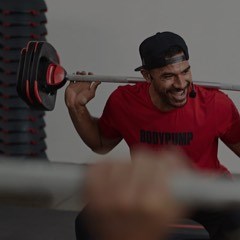60-second summary:
- Regular core-focused group workouts can shave over a minute off the average runner’s 5km time and optimise overall performance by reducing the potential for injuries.
- To maximize long-term results, runners should take an integrated approach to training, incorporating club offerings like core workouts into their program.
- In the US alone, the number of runners is roughly equivalent to the country’s 60.9m health club members.
- Treadmill running has been tipped as one of the hottest fitness trends of 2019 in the health club market, with a boutique boom opening up fresh opportunities.
If you have members in your club that are trying to improve their running performance, inviting them into your CXWORX class could help them shave precious seconds off their run time and improve their overall functional fitness.
That’s according to new research published in The Journal of Sports Medicine and Physical Fitness that reveals how regular core-focused group workouts can shave over a minute off the average runner’s 5km time and optimise their overall performance by reducing the potential for injuries.
Researchers said that to maximize long-term results, runners should take an integrated approach to training, incorporating health club offerings like core workouts in addition to their usual running program.
For the study, participants completed three Les Mills CXWORX™ workouts a week for six weeks. The 30-minute workout involves a combination of exercises designed to develop three-dimensional core fitness.
Each class includes planks, lower abdominal endurance exercises, gluteal training, abdominal oblique challenges, and extensor endurance. Together, this combination of integrated exercises simultaneously works large muscle groups from shoulder to knee, rather than isolated exercises like crunches that focus on individual core muscles.
At the end of the six-week study, participants' running speed increased and running economy improved. They decreased their 5km run times by an average of 66 seconds without a significant difference in mean heart rate, and increased their ability to hold a plank by over 60%.
Dr Jinger Gottschall, who was Associate Professor at Penn State University and lead researcher of the Les Mills Running & Core Training Study, says her findings demonstrate that runners can improve their performance by focusing on integrated core exercises that target big muscle groups around the hips, lower back, glutes and abs.
“This research establishes the critical three-dimensional core component of running training,” says Gottschall, herself a long-time running enthusiast. “Endurance athletes typically live by the slogan ‘more is better’ and simply run more miles. Our research demonstrates that integrated core training is a missing component that can improve performance and symmetry.”
Running is a three-dimensional activity, Gottschall explains. While your legs are moving forward in one plane, the movement of your arms and torso moving in another plane is also important for force production and running economy.
“Integrated core exercises are valuable to all runners – whether they're people who run marathons or those who run a few times a week to help stay fit. But they‘re also advantageous for all endurance athletes, including cyclists and swimmers.”
A global race
The global running industry has seen significant growth in recent years, buoyed by a boom in 5k and 10k races, as the emergence of obstacle course races and mass participation events. In the US alone, the number of runners is roughly equivalent to the country’s 60.9m health club members.
Many major sports brands have already sought to tap into this growth by fostering communities, with examples ranging from the high profile Nike Running Club right the way through to a pop-up pub launched recently by New Balance and Strava, where runners can earn free drinks based on how many miles they’ve clocked up.
In the health club market, treadmill running has been tipped as one of the hottest fitness trends of 2019 as boutiques have breathed new life into what was once considered ‘the most boring part of the gym’.
Premium fitness operator Equinox is launching a new standalone studio concept in New York to leverage the rising demand for treadmill-based workouts, which will be quickly followed by a location in Los Angeles later in the year. Meanwhile, treadmill-focused fitness concepts such as Barry’s Bootcamp and Orangetheory continue to expand globally.
For clubs looking to tap into this trend, the study suggests that the injury prevention benefits of core-focused group workouts could prove just as enticing to runners as the uplift in performance.
Staying on track
With an estimated one in five race runners never making it to the start line due to the heavy toll of training, injuries such as Achilles tendinopathy, plantar fasciitis and stress fractures in the metatarsals are the scourge of many a runner.
Among the participants in the study, findings showed that the joint with the greatest improvement in symmetry was the ankle, with significant differences not only during level running but also during uphill angles. More specifically, ankle range-of-motion asymmetry decreased by 46% while running at level on a treadmill (no incline), by 36% while running at a 3% incline, and by 33% running at a 6% incline.
“The results of this study demonstrate that an integrated combination of exercises could be extremely beneficial in terms of improving joint symmetry for injury reduction, deep hip muscle training for knee alignment, and abdominal training for efficient force transmission,” Gottschall says.
“Unlike previous studies that have used an isolated strengthening approach to help improve running performance, this study predominantly included a series of three-dimensional integrated exercises. The faster running speeds and increased economy were likely due to the unique sequence of integrated exercises in CXWORX.
“The majority of these injuries could potentially be minimized with a reduction in impact forces with additional activation of the core or improved symmetry between the legs,” Gottschall says.
About the study
The 12 healthy adults (eight women, four men) who took part were recreationally active, running at least three miles, three times per week, but they did not engage in any type of strength training.
Six participants (four women and two men) were assigned to the integrated, functional core training protocol three times a week for 30 minutes, for six weeks.
The remaining six maintained their usual, weekly running routine.
Joint range-of-motion data was collected to assess stride symmetry, heart-rate data during an economy treadmill test, as well as heart-rate data during a 5km run to evaluate performance.
Measuring improvements in stride asymmetry required the analysis of each and every one of the participants’ steps at three different treadmill gradients, producing thousands of data points.
The Polar M400 with a chest transmitter was used for capturing GPS and heart rate recordings. These measurements were completed both before and after the participants attended 18 Les Mills CXWORX classes in a six week period while maintaining their existing running programs.
* Hreljac A, Marshall RN, and Hume PA. Evaluation of lower extremity overuse injury potential in runners. Med Sci Sports Exer 2000:32;1635-1641.
A link to the paper published in The Journal of Sports Medicine and Physical Fitness is available here.
And to stay up to date with the latest research findings keep visiting the Les Mills website and to learn more about our past work check out lesmills.com/research








